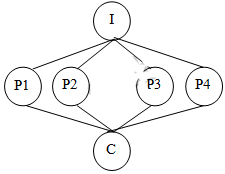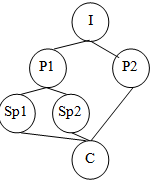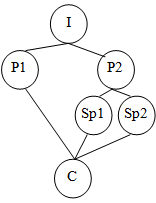Join us in the summer in Oxford on our award-winning Oxford Summer School,which provides students from all over the world with the chance to live,study and have dinner in colleges of the University of Oxford.
Merton College
The foundation of Merton dates back to 1264.The college's library is the oldest library in the university, built in three stages from 1288 to 1378. Merton has a desirable city-centre location just off the High Street, although stepping into its peaceful gardens can make the hustle and bustle(喧嚣) of everyday Oxford seem a million miles away. Oxford Royale Summer School students staying at Merton College are guaranteed easy access to Oxford's many attractions and amenities(便利设施) with key historical sites on their doorstep.The college has a reputation for academic excellence.
The Queen's College
The Queen's College is one of Oxford's oldest and most central colleges, located on the High
Street in the city centre.It was founded in 1341 and named after Queen Philippa of Hainault.Owing to its central location,Oxford Royale Summer School students staying at the Queen's College will have easy access to Oxford's many attractions and amenities.
St Peter's College
St Peter's is one of the University of Oxford's youngest colleges.It was founded in 1929 as an independent hostel for students with the aim of providing low-cost education.In 1961,St Peter's became a college of the university.The college site includes a combination of different styles of architecture,with a mixture of traditional and modern buildings. Recently the college sports teams have been very successful,especially the boat club.
St Catherine's College
St Catherine's College is the University of Oxford's youngest undergraduate college,founded in 1962.The striking glass and concrete buildings were designed by Arne Jacobsen,combining modern building materials with the traditional college.The college is also proud of numerous Nobel Prize winners,including Sir John Vane and John E.Walker.St Catherine's College is a short walk away from Oxford's citycentre.
1. What can you do if you go to Merton College?| A.Live in modern buildings. | B.Visit the Nobel Museum. |
| C.Shop in the High Street. | D.Join the boat club. |
| A.It is close to Oxford's city-centre. | B.It is younger than the other schools. |
| C.It has many traditional buildings. | D.It is known for its academic excellence. |
| A.St Peter's College | B.Merton College |
| C.the Queen's College | D.St Catherine's College |
相似题推荐
【推荐1】Nonverbal communication is a broad term used to describe any method of conveying information without words. Whether intentional, based on societal cues (提示), or completely unconscious, common forms of nonverbal communication include body language and facial cues, fashion and personal clothing, hand gestures, as well as graphical signs and design.
It is important to note that nonverbal communication is really about a lack of words, rather than a lack of speech sounds. That means writing would be considered verbal communication while sounds like grunts (嘟哝) would not.
Nonverbal communication can be broadly divided into relatively universal forms and culturally dependent forms. Many facial expressions, for example, are relatively universal, with most cultures able to identify expressions of fear, joy, or anger. On the other hand, nonverbal cues like bowing, shaking hands,or flashing a peace sign are culturally characteristic, and therefore have little meaning outside of cultures that understand them.
Fashion is a form of nonverbal communication, and in many modern cultures is a hugely important way in which people telegraph things about themselves.
Gestures also act as a form of nonverbal communication. A wide range of hand gestures can be found in most cultures, and in the west there are some almost universal gestures, such as a wave goodbye, a thumbs-up to show everything is okay, or handy outspread to signify offerings.
Body language is one of the most studied forms of nonverbal communication, and deals with how the body rests, how it is situated in relation to other bodies, and the special distance between bodies. For example, turning towards a person when seated and speaking to them is a nonverbal cue showing interest, while turning away shows a lack of interest. Tipping your head slightly is a form of nonverbal communication to show curiosity or express that you are listening closely or what they are saying, while constantly looking away would show a lack of attention.
1. What is the purpose of the author in writing the text?| A.To explain what nonverbal communication is. |
| B.To introduce some universal body languages. |
| C.To compare nonverbal cues and verbal ones. |
| D.To discuss the cultural shock of communication. |
| A.smiling | B.grunting |
| C.bowing | D.screaming |
| A.Body language is the most frequently studied by scientists. |
| B.Body language relies on body movements to convey messages. |
| C.Body language can be used to express your different meanings. |
| D.Body language varies very slightly from one country to another. |
【推荐2】After a day’s labor, Andreas Fichtner and his colleagues have spliced (绞接) together three segments of fibers, creating a 12.5-kilometer-long fiber-optic (光学的) cable. It will stay buried in the snow to spy on the activity of Grfmsvotn, a dangerous, glacier-covered volcano.
Fichtner, a geophysicist at the Swiss Federal Institute of Technology, in Zurich, is one of the researchers using fiber optics to take the pulse of our planet. Much of their work is done in remote places, from the tops of volcanoes to the bottoms of seas, where traditional monitoring is too costly or difficult.
The technique used by Fichtner’s team is called distributed acoustic sensing, or DAS. “It’s almost like radar in the fiber,” says the physicist Giuseppe Marra of the United Kingdom’s National Physical Laboratory, in Teddington. While radar uses reflected radio waves to locate objects, DAS uses reflected light to detect events as varied as earthquake activity and moving traffic, and to determine where they occurred. Inside the cables are optical fibers. DAS involves shooting quick pulses of laser light down the fiber and detecting bits of light that scatter back to the laser source due to disturbances in the environment. When the earth’s surface vibrates and shifts, it pulls the cables, so a detector can identify these small changes.
The New York Times points out that although wireless and satellite technology are booming, good old-fashioned cables are still the most efficient way to send information across oceans. Repurposing cables could give scientists the ability to monitor high-risk zones that were previously hard to reach. They could help detect earthquakes and tsunamis a few seconds earlier than traditional warning systems.
In addition, fiber-optic cables could also help solve some of the biggest challenges for humans. In the recent years, scientists have started to use them to measure ocean waves and access fault (断层) information. It is believed that fiber-optic cables will serve to benefit us greatly in the future.
1. What is the purpose of the work of Fichtner’s team?| A.To track volcanic activities. | B.To strike oil under the sea. |
| C.To lengthen fiber-optic cables. | D.To keep fibers covered in the snow. |
| A.It determines when and where disasters occurs. |
| B.It uses radio waves to locate moving objects. |
| C.It improves the efficiency of transmitting light. |
| D.It detects tiny variation of the earth’s surface. |
| A.Recycling cables in new fields. | B.Adapting cables for a new function. |
| C.Installing cables beneath volcanoes. | D.Promoting cables into massive production. |
| A.DAS Is Feeling the Heartbeat of Volcanoes |
| B.Satellite Technology Is Booming in Our Times |
| C.Underground Cables Are Taking the Planet’s Pulse |
| D.Fiber-optic Cables Are Giving Us Insights into Earthquakes |
【推荐3】For 30 years, Alaska's northern fur seal population has not increased. But the ocean mammals are appearing in growing numbers in one unlikely place-a small island that forms the tip of an active undersea volcano. Bogoslof Island is distant and unpopulated. It sits in the eastern Bering Sea. Openings on the ground there release mud, steam and sulfurous gases, but northern fur seals find the island to be a good place for giving birth and raising their young.
It is unclear why the seals have chosen to live on an active volcanic island instead of other unpopulated islands in the area. "The surface is covered with these big blocks, some as big as 10 meters in length, which were exploded out of the vent,” said Chris Waythomas, a U.S. Geological Survey research scientist.
Northern fur seals get their name from their extremely thick fur; they have about 60,000 hairs per square centimeter. When Russian Emperor Alexander II needed money and decided to sell Alaska to the United States in 1867, fur was one of the future state's known valuables.
Most of the world's northern fur seals live in the eastern Bering Sea area. They live in the ocean from November to June and return to land in summer, when they breed and nurse pups. Between 1950 and 1988, the northern fur seal population dropped from 2.1 million to 1.1 million. Scientists do not know why they have not made a comeback. Northern fur seals were first seen on Bogoslof in 1980. NOAA researchers have since carried out periodic studies of the population.
Volcanic activity on Bogoslof has remained mostly stable. But Gelatt's crew chose not to camp there during their week-long visit in August. They feared an explosion could shoot up huge rocks. Instead, they made day trips from a secured boat. The crew counted the number of seals and examined whether images taken from above by an unpiloted aircraft could be used in future counts.
1. What's the text mainly about?| A.The scientists are worried about the extinction of seals. |
| B.The environment protection is crucial to wild animals. |
| C.The northern fur seals are on the rise on Bogoslof Island. |
| D.The northern fur seals like distant and unpopulated places. |
| A.The conditions on Bogoslof Island are tough and terrible. |
| B.An active undersea volcano makes Bogoslof Island livable. |
| C.Bogoslof Island is suitable for the northern fur seals to live on |
| D.It's reasonable for the northern fur seals to live on a small island. |
| A.The northern fur seals breed and nurse pups in winter. |
| B.The northern fur seals' thick fur is of no value nowadays. |
| C.There were about 1.1 million northern fur seals on the island. |
| D.It's not clear why northern fur seal population has not increased. |
| A.By observing in the distance. |
| B.By doing the research inside an aircraft. |
| C.By taking a boat with protective equipment every day. |
| D.By using photos shot by an unmanned vehicle to count seals. |
【推荐1】Academic demands are a key source of stress for college students. Unlike in high school, students in college are expected to manage their workload without much guidance from teachers, and it’s easy to feel lost in a class with several hundred peers. Our research suggests that, on average, stress goes up as academic demands go up, peaking ahead of final exams and then falling again.
It can be comforting to know that academic stress is a shared experience. It may also help to know that temporary increases in stress can benefit students under some circumstances. Our longer-term research across four years found that students earned higher grades in semesters when they experienced bout of (一阵) negative moods. A rise in negative moods one semester may reflect that extra effort was needed to meet academic challenges. The important reminder here is that we only observed this effect for students who were typically happy overall, showing the importance of maintaining good emotional balance.
Some students can’t adapt themselves to the life without support and care from their families. For example, international students who live further away from their families may feel homesick stronger. Maintaining friendships and balancing social demands with academics is another key source of stress for college students. In college, the relationship between students and teachers can be totally different from in high schools. It is hard for some students to be involved in college class.
What distinguished the students who reported less stressed and more satisfaction across the year, including during their job search, was their outlook. Despite plans not working out exactly as hoped, recent graduates with greater well-being were able to increase effort and keep moving forward through challenges. These graduates were also moving forward with a sense of purpose, or a general sense that they were on a meaningful path, and optimism about the path they were on, expecting good things to happen in the future.
Additionally, their expectations about how and when their goals would be achieved were flexible, and they were open to new or unexpected opportunities. Finally, recent graduates with greater well-being also had more supportive social networks that they could rely on for advice, comfort, and help along the way.
1. What can we learn about academic stress?| A.Top college students seldom have academic stress. |
| B.Students are most anxious at the start of a semester. |
| C.An increase in negative moods can make students study harder. |
| D.Students should decrease workload to maintain emotional balance. |
| A.The emotional stress of college students. |
| B.The difficulty in making friends in college. |
| C.The importance of having good teachers in college. |
| D.The reasons why international students are more stressed. |
| A.They can adjust their expectations when needed. |
| B.They can create opportunities in time. |
| C.They can give people practical suggestions. |
| D.They can avoid difficult challenges smartly. |
| A.College students. |
| B.College students’ stress. |
| C.Recent graduates. |
| D.Recent graduates’ expectations. |
【推荐2】Importance of College Education
During the high school career, students may begin to question the importance of a college education. They might find themselves asking, “Why is it important to go to college?” The answer is that, more than ever, college graduates enjoy much greater opportunities available to them than those who have not received a college education.
For many high school students, being able to immediately generate an income after graduation is an appealing thought. They may also be affected by the rising cost of tuition, and while it is true that a higher education may be one of the largest expenses you will ever face, the importance of a college education has become quite evident in terms of earning potential within today’s economy.
Why should you go to college? One important answer to this question is more opportunity. As opposed to generations of the past, high school graduates today are unable to obtain high-paying jobs that were once available. The U.S. has been transformed from a manufacturing-based economy to an economy based on knowledge, and the importance of a college education today can be compared to that of a high school education forty years ago. It serves as the gateway to better options and more opportunity.
There are additional reasons as to why it is important to go to college. When students experience a post secondary education, they have the opportunity to read books and listen to the lectures of top experts in their fields. This encourages students to think, ask questions, and explore new ideas, which allows for additional growth and development and provides college graduates with more opportunities in the job market over those who have not experienced a higher education.
The importance of a college education is also stressed because of the opportunity to gain valuable resources during the study. The more connections which are collected during your college career, the more options you will have when you begin your job search. Once you have ended your job search and have started your career, however, the importance of a college education has not been exhausted. Having a college degree often provides for greater promotion opportunity.
So, why should you go to college? The reasoning does not begin and end with the job aspect. A good education is beneficial from many different viewpoints, and though the importance of a college education is quite evident for many high school students, what is often not as clear is how they will pay for that education.
1. Why do some high school graduates prefer working to college study?| A.To obtain high-paying jobs. |
| B.To earn money at an early age. |
| C.To spend less money on tuition. |
| D.To adapt to the knowledge-based society. |
| A.too much time is spent on lectures in college study. |
| B.high school education is a gateway to more opportunity. |
| C.college graduates gain more chances over others in job market. |
| D.a college degree guarantees promotion in American companies. |
| A.Affording college education. |
| B.Changing college education. |
| C.Receiving college education. |
| D.Refusing college education. |
I: Introduction P: Point Sp: Sub-point (次要点) C: Conclusion
A. | B. |
C. | D. |
【推荐3】You might think that college is just a continuation of high school, but it’s not.
Become more independent
Explore your options
One of the great things about being able to choose your own courses is that you get the opportunity to explore. You can try classes in a lot of different subjects.
Explore outside the classroom
Thanks to all the knowledge。skills and experience you’ll gain in college, you’ll be able to adapt to a greater variety of jobs and careers. Statistics show that a college diploma(毕业文凭) can help you get a job more easily, keep a job and achieve your dream.
| A.Connect with new friends |
| B.Unlock more job opportunities |
| C.You’ll encounter new ideas and challenges |
| D.Or you can get right into a favorite subject |
| E.College is about much more than just course work |
| F.College opens doors for you that high school doesn’t |
| G.College helps students develop into responsible and independent adults |



